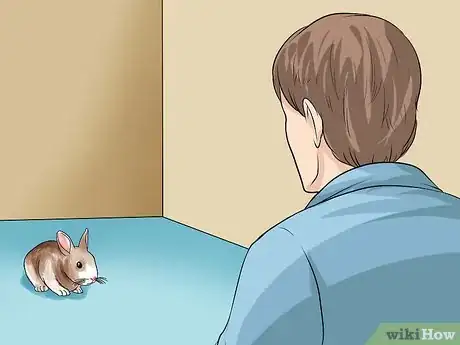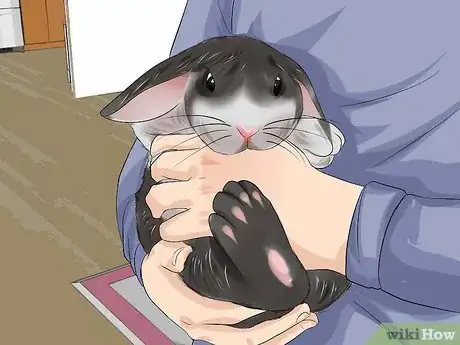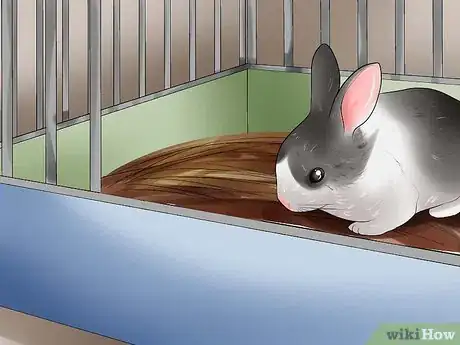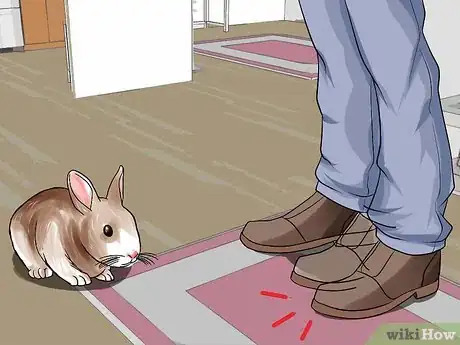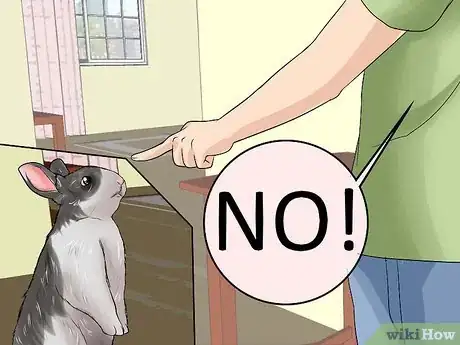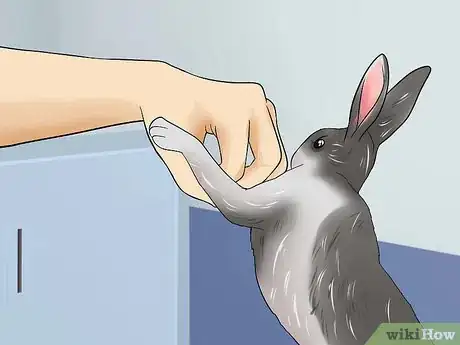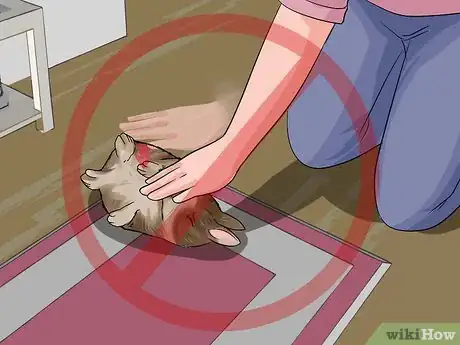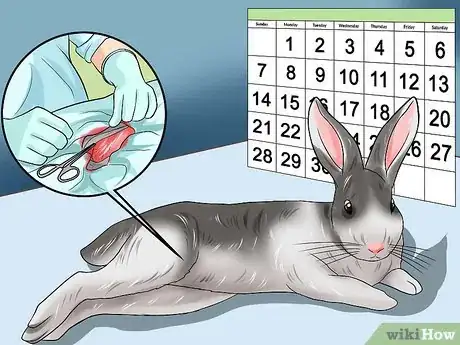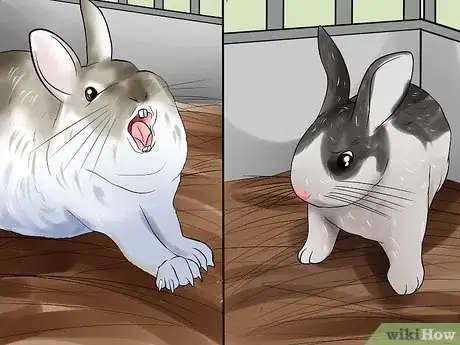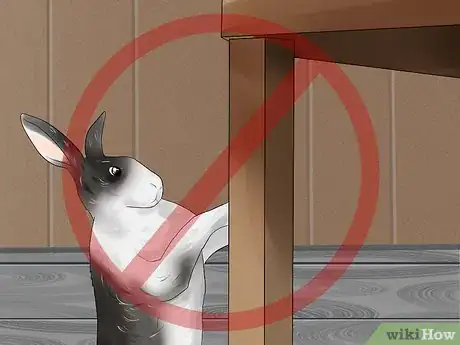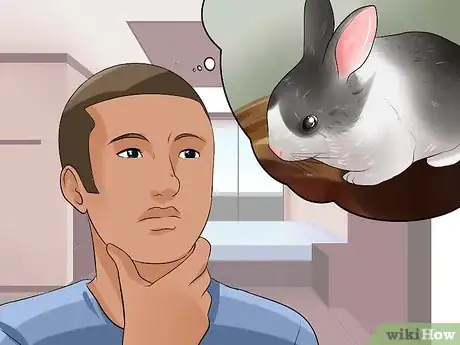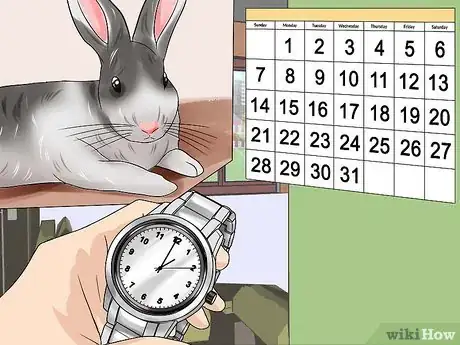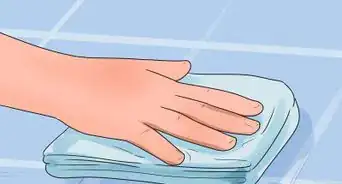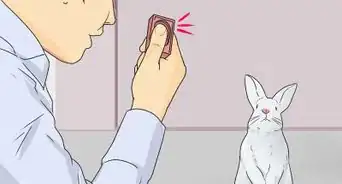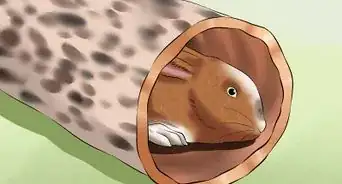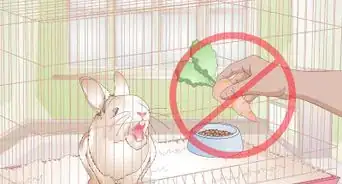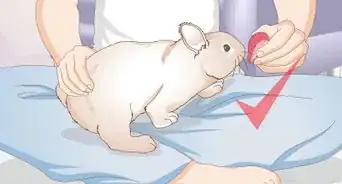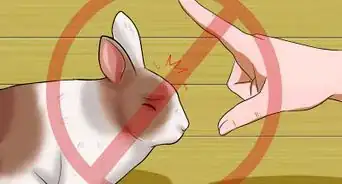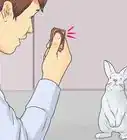This article was co-authored by Pippa Elliott, MRCVS. Dr. Elliott, BVMS, MRCVS is a veterinarian with over 30 years of experience in veterinary surgery and companion animal practice. She graduated from the University of Glasgow in 1987 with a degree in veterinary medicine and surgery. She has worked at the same animal clinic in her hometown for over 20 years.
This article has been viewed 62,458 times.
Rabbits can be friendly and playful, but the moment you try to put them back in their cage, they can sometimes become aggressive. Rabbits are naturally burrowing animals, so despite their generally good nature, they might scratch or "dig" on you from time to time. With patience and proper training, most rabbits can be taught to abandon this behavior.
Steps
Gaining Your Rabbit’s Trust
-
1Approach your rabbit slowly. Rabbits are less domesticated than many animals you may be accustomed to dealing with. While your cat is not intimidated by you as you approach, a rabbit likely is. In order to establish that you are not a threat to your rabbit, take your time with it.[1]
- Start by sitting next to the rabbit while it is still in its cage and let it get accustomed to your presence. Speak to it so it can get used to the sound and vibration of your voice.
- Give the rabbit treats like bits of banana or apple.
- After the rabbit is accustomed to having you around, open the cage and pet it softly to demonstrate that you are not a threat.
-
2Spend time with your rabbit. In order to establish the trust you need your rabbit to have for you, you should spend time with it every day. Trust takes time, and you need to continue to spend time with your rabbit to maintain it.[2]
- Try to spend several minutes a day with your rabbit to establish and maintain trust.
- Incorporate other people so the rabbit learns to trust people, instead of just you.
Advertisement -
3Respect your rabbit’s territory. If your rabbit scratches at you when you try to remove it from its cage, it may be because rabbits are very territorial animals. Giving your rabbit domain over its cage may reduce its aggressive tendencies.[3]
- Instead of opening the cage and taking the rabbit out, try opening the cage and allowing the rabbit to leave on its own.
- Using treats to entice the rabbit out of the cage is a great way to give it the space it wants while still removing it on your schedule.
Training the Rabbit Through Your Behavior
-
1Use body language to teach the rabbit lessons. Rabbits are keenly aware of their surroundings and will recognize changes in your body language. If you want to indicate your displeasure with something the rabbit is doing, change up your body language so it recognizes a difference.[4]
- Stomping your foot is an audible way to get the rabbit’s attention and demonstrate that you are not happy with what it’s doing. The rabbit may react fearfully to this the first few times, so be sure to give it space.
- Turning your back to your rabbit will let it know that you are unhappy with it and over time can adjust the rabbit’s behavior.
-
2Say no to your rabbit. Rabbits are not able to understand English commands like other species, but you can demonstrate your displeasure with your rabbit’s scratching by using the same audible sound and tone in conjunction with stomping your foot or turning your back.[5]
- Say no with the same tone and volume each time you use it.
- Using it in conjunction with stomping or turning your back will help establish that hearing your say “no” is a negative thing on par with other methods you use to train the rabbit.
-
3Teach the rabbit what’s unacceptable by ignoring it. When your rabbit does scratch you, the way you react can teach it what does and does not work. While negative reinforcement does not work with rabbits, ignoring them does.[6]
- If the rabbit scratches you to get your attention or voice its displeasure with a situation, ignore it.
- If you react, the rabbit will learn that scratching is an effective method to get your attention.
-
4Never strike a rabbit. Although you may be tempted to swat at your rabbit when it scratches you, doing so will only reinforce the rabbit’s fears that you are a threat. Hurting the rabbit will cause it act more aggressively in your presence.[7]
- Even just tapping your rabbit on the nose could lead the rabbit to believe that you are a physical threat, causing it to scratch to try to get away from you.
- Your rabbit must feel comfortable in your presence in order to prevent bad behavior.
-
5Have your rabbit fixed. Rabbits can become dramatically more aggressive once they reach four months of age, as this is when they enter the mating stage of their life. If you do not have your rabbit fixed at this age, hormones can make the rabbit very aggressive.[8]
- Rabbits are calmer and more docile after being fixed, which makes them better pets and reduces problem behavior.
- Fixing your rabbits will make it so you can safely keep more than one rabbit together without violence or reproduction issues.
Changing the Way You Think About Training
-
1Recognize the difference between anger and fear. While rabbits may be capable of experiencing anger, it is highly unlikely that your rabbit is angry or doesn’t like you. It’s much more likely that your rabbit is simply afraid.[9]
- Young rabbits may not know the difference between you and a predator, so they may try to escape your grasp by scratching or biting.
- Only once a rabbit is comfortable around you will it stop scratching to escape.
-
2Work within your limits. Rabbits do not possess the intelligence of most dog breeds, so training a rabbit in a similar fashion will not yield similar results. Rabbits are, first and foremost, wild animals that are concerned with survival.
- Rabbits are not extremely trainable animals, so you should still keep things you don’t want scratched or bitten out of their reach.
- “Rabbit-proofing” your house by limiting the rabbit’s access to things you don’t want ruined is the only completely effective way to prevent rabbits from scratching or biting through things you don’t want them to.
-
3Think like a rabbit. Rabbits don’t perceive the world in the same way that you do. Rabbits think in terms of patterns. They observe your behavior as well as their own, and come to expect the same results from the same behavior.[10]
- If your rabbit regularly scratches you, pay attention to what you are doing leading up to it scratching. You may be frightening it without realizing. Once you note what of your behavior elicits the rabbit's scratching, try not use that behavior anymore.
- Understanding that rabbits learn in patterns can make it easier to train the rabbit. When it scratches you, turn your back and say no. When it doesn’t scratch, reward it with affection. Eventually it will learn the pattern.
-
4Be patient. While rabbits can learn not to scratch, changes don’t happen overnight. Continue to exercise the methods you choose to teach the rabbit that scratching isn’t appropriate behavior until the rabbit’s behavior actually changes.[11]
- Use the same methods to indicate the rabbit is misbehaving consistently to help it learn faster. If you choose to stomp and say no, do that every time. Switching it up will slow the learning process.
- It can take weeks for a rabbit to develop trust, then longer for it to change its behavior based on your training.
- Remember that you aren’t just changing the rabbit’s behavior, you are changing its perception of the world and reducing its fear of humans. Such deep changes take time.
References
- ↑ https://pethelpful.com/rabbits/Yes--Your-Rabbit-Hates-You-How-To-Be-Friends-With-Your-Bunny
- ↑ http://rabbit.org/faq-aggression
- ↑ http://rabbit.org/faq-aggression/
- ↑ https://pethelpful.com/rabbits/Bunny-Care-Guide-How-To-Discipline-Your-Rabbit
- ↑ https://pethelpful.com/rabbits/Bunny-Care-Guide-How-To-Discipline-Your-Rabbit
- ↑ http://rabbit.org/faq-aggression/
- ↑ https://pethelpful.com/rabbits/Bunny-Care-Guide-How-To-Discipline-Your-Rabbit
- ↑ http://rabbit.org/faq-aggression/
- ↑ http://rabbit.org/faq-aggression/
About This Article
To teach a rabbit not to scratch, gain its trust by approaching it slowly, sitting next to its cage, and giving it bits of fruit by hand every day so your rabbit learns that you're not a threat. Since rabbits are territorial and may scratch if you try to reach into their cages, open your rabbit’s cage and allow it to come out when it’s ready. If your rabbit does try to scratch, use body language, like stomping your foot or turning your back, to show your displeasure. You can also tell your rabbit “No” as you stomp or turn away to establish that this behavior is not wanted. However, never yell at or harm your rabbit, as this will only reinforce the idea that you're a threat. For more tips from our Veterinary co-author, including how to ignore your rabbit’s scratching, keep reading!
